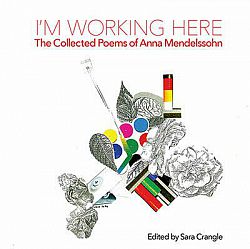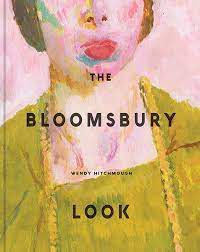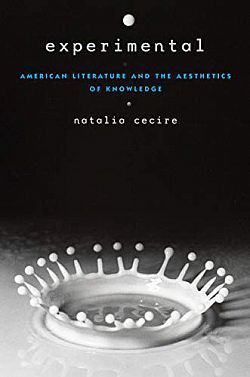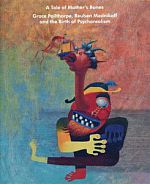Recent publications
- Sussex Modernism (2025)
Hope Wolf, Sussex Modernism (Yale University Press, April 2025)
A look at how artists and writers harnessed the landscapes, cultures, and histories of their locations to reimagine how art should be made and life lived.
- Reading Modernism's Readers (2024)
Helen Tyson, Reading Modernism's Readers: Virginia Woolf, Psychoanalysis and the Bestseller (Edinburgh University Press, July 2024)
Examines the scene of reading in modernism, psychoanalysis and popular novels from the early twentieth century.
- Elevated Realms - An Anatomy of Mina Loy (2024)
Sara Crangle, Elevated Realms – An Anatomy of Mina Loy (Edinburgh University Press, April 2024)
A uniquely comprehensive, groundbreaking two-volume study of Loy’s relationship to the human body and soul.
- I’m Working Here: The Collected Poems of Anna Mendelssohn (2021)
 Sara Crangle, I’m Working Here: The Collected Poems of Anna Mendelssohn (Shearsman, 2021)
Sara Crangle, I’m Working Here: The Collected Poems of Anna Mendelssohn (Shearsman, 2021)Author and artist Anna Mendelssohn was born near Manchester in 1948. Between 1971 and 1976, she served time in London’s Holloway Prison due to her involvement in extreme leftist activism. From the 1980s, she resided and studied in Cambridge, publishing 15 poetry collections and contributing to landmark anthologies of the British Poetry Revival, among them, Denise Riley’s Poets on Writing (1992) and Iain Sinclair’s Conductors of Chaos (1996). After her death in 2009, her children donated her archive to the University of Sussex.
In theme and style, Mendelssohn’s poems draw on an expansive, post-1850 avant-garde lineage that includes Baudelaire, Stein, Akhmatova, Hikmet, Lorca, and Raworth. Attuned to the fraught legacy of the female vanguard writer, as well as to disparities of class and race, Mendelssohn’s poems are charged, acute, and probing. Part aesthetic treatise (“a poem is not going to give precise directions”); part antipolitical manifesto (“the war is too close / for revolution to be understood”); part lament (“softly the sound of woe / gallops”); part celebration of poetic sound and possibility (“I worship at the shrine of poetry”), Mendelssohn’s writing resolutely resists containment or category. This scholarly edition is the first replete collection of the poems Mendelssohn published or prepared for circulation.
- Feminism’s Archives: Mina Loy, Anna Mendelssohn and Taxonomy (2021)
Sara Crangle, ‘Feminism’s Archives: Mina Loy, Anna Mendelssohn and Taxonomy’ in Douglas Mao ed., The New Modernist Studies (Cambridge University Press, 2021)
This is the first book specifically devoted to the new modernist studies. Bringing together a range of perspectives on the past, present, and future of this vibrant, complicated scholarly enterprise, the collection reconsiders its achievements and challenges as both a mode of inquiry and an institutional formation. In its first section, the volume offers a fresh history of the new modernist studies' origins amid the intellectual configurations of the end of the twentieth century and changing views of the value, influence, and scope of modernism. In the second section a dozen leading scholars examine recent trends in modernist scholarship to suggest possible new paths of research, showing how the field continues to engage with other areas of study and how it makes a case for the ongoing meaning of modernist literature and art in the contemporary world.
- Falling in Love with Everyone: Lessing’s Letters to Smithie at the Keep, University of Sussex (2021)
Pam Thurschwell, ‘Falling in Love with Everyone: Lessing’s Letters to Smithie at the Keep, University of Sussex’, (2021), Critical Quarterly, Vol.63 No.1.
The correspondence, now at the Keep, University of Sussex, is a document of Lessing’s youth and a test ament to the obligation to ‘fall in love with everyone’ in the times she was living through.The intermingling of sex and social protest, radical politics and radical personal relations that the correspondence reveals, is key for understanding Lessing’s autobiographical and fictional portrayals of her years in Rhodesia during World War II. Lessing’s letters to Smithie add crucial nuance to Lessing’s many retellings of her life in her mid-20s in Rhodesia.
- ‘Forebodings of Fascism’: Marion Milner and Virginia Woolf (2021)
Helen Tyson, ‘Forebodings of Fascism’: Marion Milner and Virginia Woolf, Feminist Modernist Studies, 2021
In A Life of One’s Own (1934) Marion Milner asked the apparently simple question: “What do I like?” By 1937, however, when Milner published An Experiment in Leisure, the question “What do I like?”, and the urgency of answering it, had shifted. Writing against the backdrop of a rising current of fascism across Europe, there was a new urgency for Milner, in 1937, in understanding the apparent ease with which, not only Hollywood movie-makers, but now also European dictators might manipulate individual desires. Focusing on portraits of reading from Virginia Woolf’s 1937 novel, The Years, alongside Milner’s 1937 An Experiment in Leisure, this article explores Woolf’s and Milner’s shared—and deeply anxious—fascination with what Milner described, in her 1950 book On Not Being Able to Paint, as the “Monsters within and without.” This article tracks Woolf’s and Milner’s encounters with the internal and external “monsters” haunting 1930s Europe, showing how, for both writers, the historical vicissitudes of fascism traversed the terrains of psychic, cultural, and political life. Both Woolf and Milner, Tyson argues, were engaged in an endeavour to understand the entanglement of the psychic, social and political forces at work in our everyday acts of leisure and reading.
- The Bloomsbury Look (2020)
Hitchmough, Wendy (2020) The Bloomsbury Look. Yale University Press, London. ISBN 9780300244113
 An in-depth study of how the famed Bloomsbury Group expressed their liberal philosophies and collective identity in visual form
An in-depth study of how the famed Bloomsbury Group expressed their liberal philosophies and collective identity in visual formThe Bloomsbury Group was a loose collective of forward-thinking writers, artists, and intellectuals in London, with Virginia Woolf, John Maynard Keynes, and E. M. Forster among its esteemed members. The group’s works and radical beliefs, spanning literature, economics, politics, and non-normative relationships, changed the course of 20th-century culture and society. Although its members resisted definition, their art and dress imparted a coherent, distinctive group identity.
Drawing on unpublished photographs and extensive new research, The Bloomsbury Look is the first in-depth analysis of how the Bloomsbury Group generated and broadcast its self-fashioned aesthetic. One chapter is dedicated to photography, which was essential to the group’s visual narrative—from casual snapshots, to amateur studio portraits, to family albums. Others examine the Omega Workshops as a design center, and the evidence for its dress collections, spreading the Bloomsbury aesthetic to the general public. Finally, the book considers the group’s extensive participation in 20th-century modernism as artists, models, curators, critics, and collectors.
- Scherzos Benjyosos (2020)
Sutherland, Keston (2020) Scherzos Benjyosos. The Last Books, Amsterdam. ISBN 9789491780325
Scherzos Benjyosos is a set of four poems, scherzos in prosimetrical blocks, a comical, wild, and delirious sifting through the carnage of the financial crash, the dreamscapes of capitalist infancy, histories of sadism and persecution, the fetish bars of canonical literature, and the psychoanalysis of grass. The book also includes 'Sinking Feeling', Sutherland's long poem from 2017, described by J.H. Prynne as 'breathtakingly lovely, and desperate, racked with desire to become truthful love'.

- Experimental: American literature and the aesthetics of knowledge (2019)
Cecire, Natalia (2019) Experimental: American literature and the aesthetics of knowledge. Hopkins Studies in Modernism . Johns Hopkins University Press, Baltimore. ISBN 9781421433776
 In this bold new study of twentieth-century American writing and poetics, Natalia Cecire argues that experimental writing should be understood as a historical phenomenon before it is understood as a set of formal phenomena. This seems counterintuitive because, at its most basic level, experimental writing can be thought of as writing which breaks from established forms. Touching on figures who are not typically considered experimental, such as Stephen Crane, Jacob Riis, Busby Berkeley, Ursula K. Le Guin, and Gottlob Frege, Experimental offers a fresh look at authors who are often treated as constituting a center or origin point of an experimental literary tradition in the United States, including Gertrude Stein, Ezra Pound, William Carlos Williams, and Marianne Moore. In responding to a crisis of legitimization in the production of knowledge, this tradition borrows and transforms the language of the sciences.
In this bold new study of twentieth-century American writing and poetics, Natalia Cecire argues that experimental writing should be understood as a historical phenomenon before it is understood as a set of formal phenomena. This seems counterintuitive because, at its most basic level, experimental writing can be thought of as writing which breaks from established forms. Touching on figures who are not typically considered experimental, such as Stephen Crane, Jacob Riis, Busby Berkeley, Ursula K. Le Guin, and Gottlob Frege, Experimental offers a fresh look at authors who are often treated as constituting a center or origin point of an experimental literary tradition in the United States, including Gertrude Stein, Ezra Pound, William Carlos Williams, and Marianne Moore. In responding to a crisis of legitimization in the production of knowledge, this tradition borrows and transforms the language of the sciences.Drawing upon terminology from the history of science, Cecire invokes the epistemic virtue, which tethers ethical values to the production of knowledge in order to organize diverse turn-of-the-century knowledge practices feeding into "experimental writing." Using these epistemic virtues as a structuring concept for the book's argument, Cecire demonstrates that experimental writing as we now understand it does not do experiments (as in follow a method) but rather performs epistemic virtues. Experimental texts embody the epistemic virtues of flash, objectivity, precision, and contact, associated respectively with population sciences, neuroanatomy, natural history and toolmaking, and anthropology. Yet which virtues take precedence may vary widely, as may the literary forms through which they manifest.
Bringing it up to the 1980s, Cecire reveals the American experimental literary tradition as a concerted and largely successful rewriting of twentieth-century literary history. She shows how the Language poets, a group of primarily white experimental writers, restored to the canon what they saw as modernism's true legacy, whose stakes were simultaneously political and epistemological: it produced a poet who was an intellectual and a text that was experimental.
- A Tale of Mother’s Bones: Grace Pailthorpe, Reuben Mednikoff, and the Birth of Psychorealism (2019)
 Hope Wolf, with Rosie Cooper, Martin Clark and Gina Buenfeld, A Tale of Mother’s Bones: Grace Pailthorpe, Reuben Mednikoff, and the Birth of Psychorealism (Camden Arts Centre and the De La Warr Pavilion, 2019)
Hope Wolf, with Rosie Cooper, Martin Clark and Gina Buenfeld, A Tale of Mother’s Bones: Grace Pailthorpe, Reuben Mednikoff, and the Birth of Psychorealism (Camden Arts Centre and the De La Warr Pavilion, 2019)Dr Grace Pailthorpe (1883-1971) and Reuben Mednikoff (1906-1972) began collaborating in 1935. This richly illustrated book includes an expansive new essay that explores how Pailthorpe and Mednikoff used a tale they told about their gender, spiritual beliefs, the critical reception their work recieved, and the rise of Facism. The book also features seven contemporary responses from the fields of art, art history, medical humanties and modern literature, bringing new theories, ideas, and approaches to an understanding and appreciation of seven individual works.